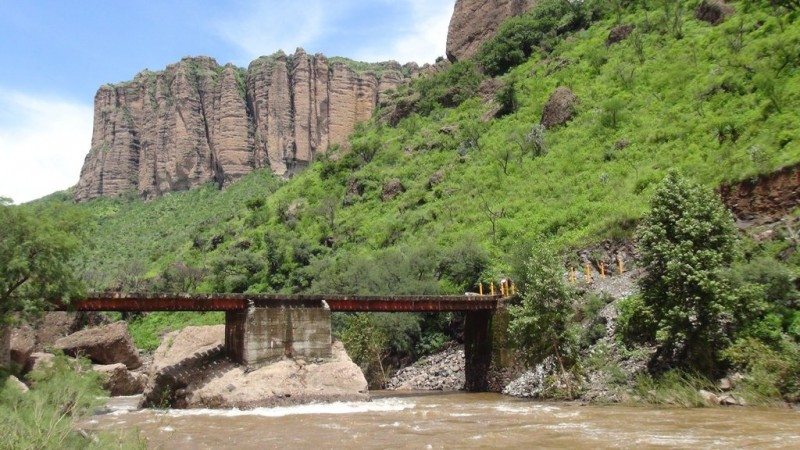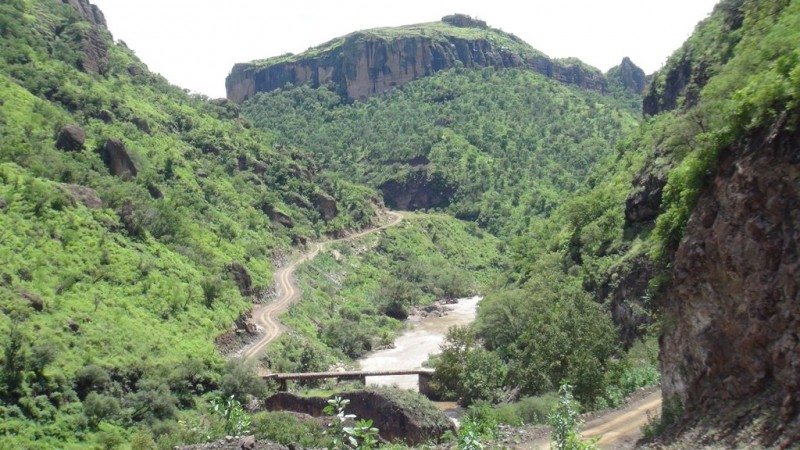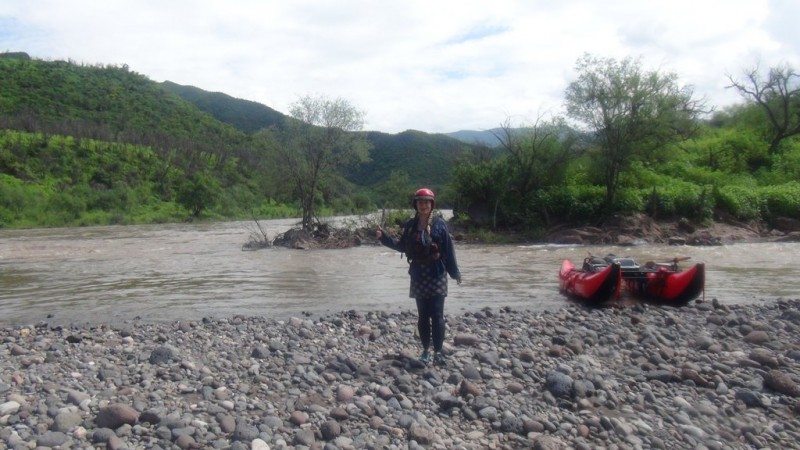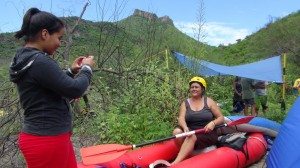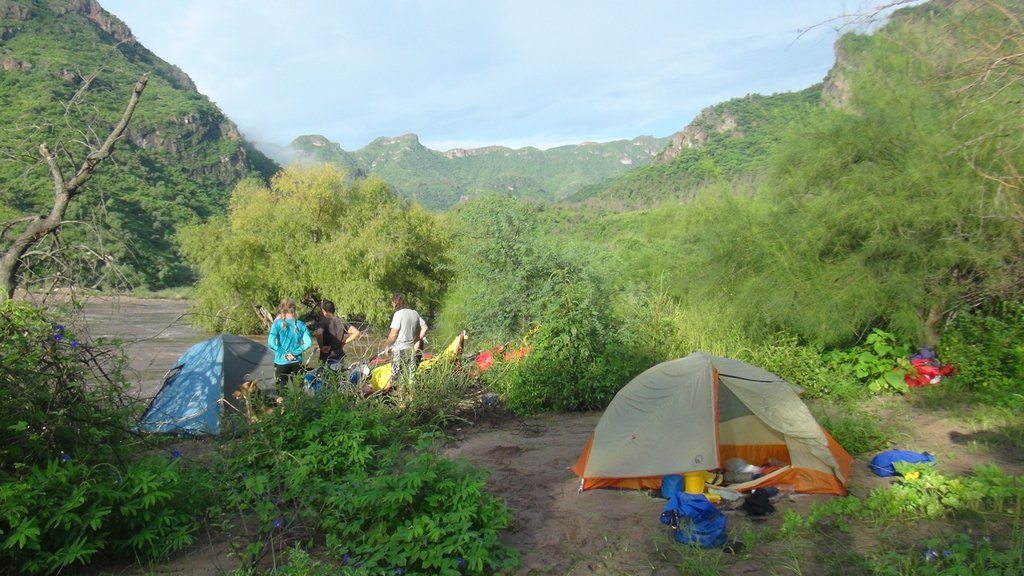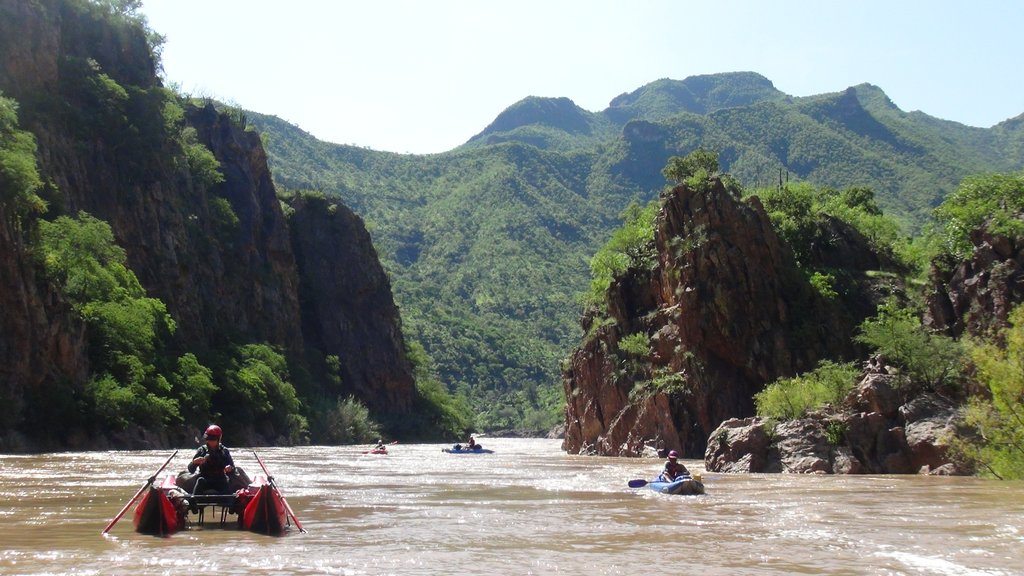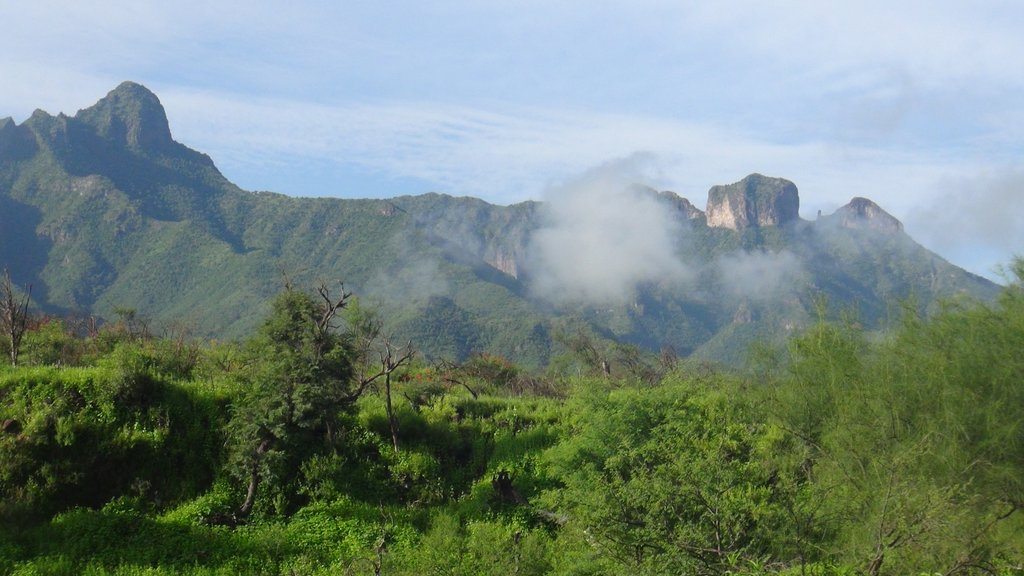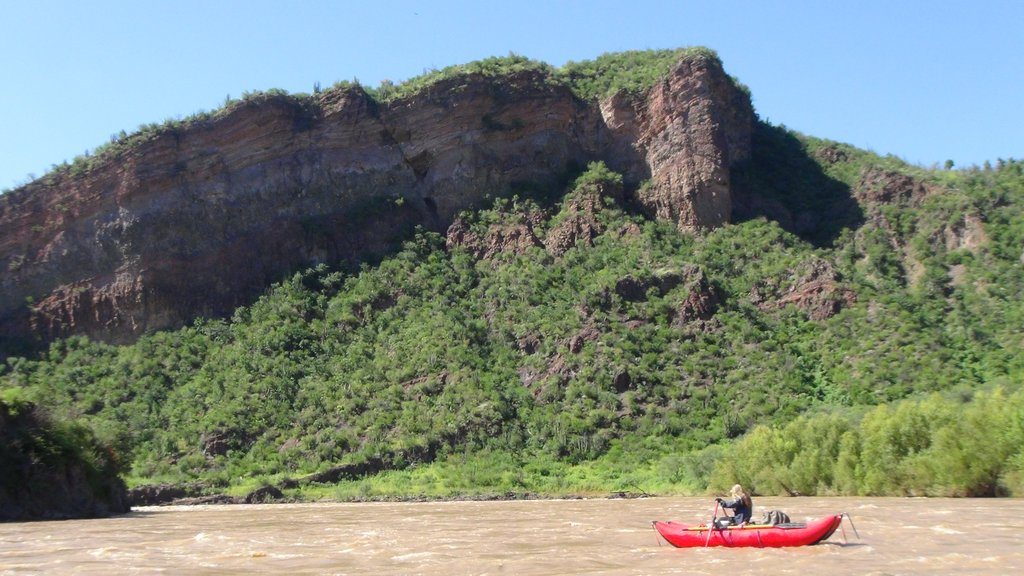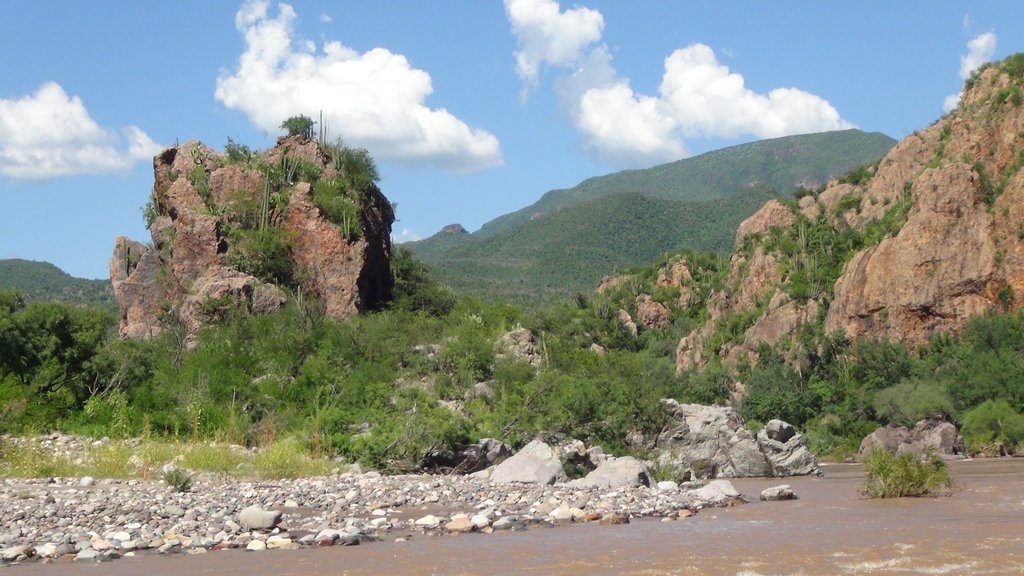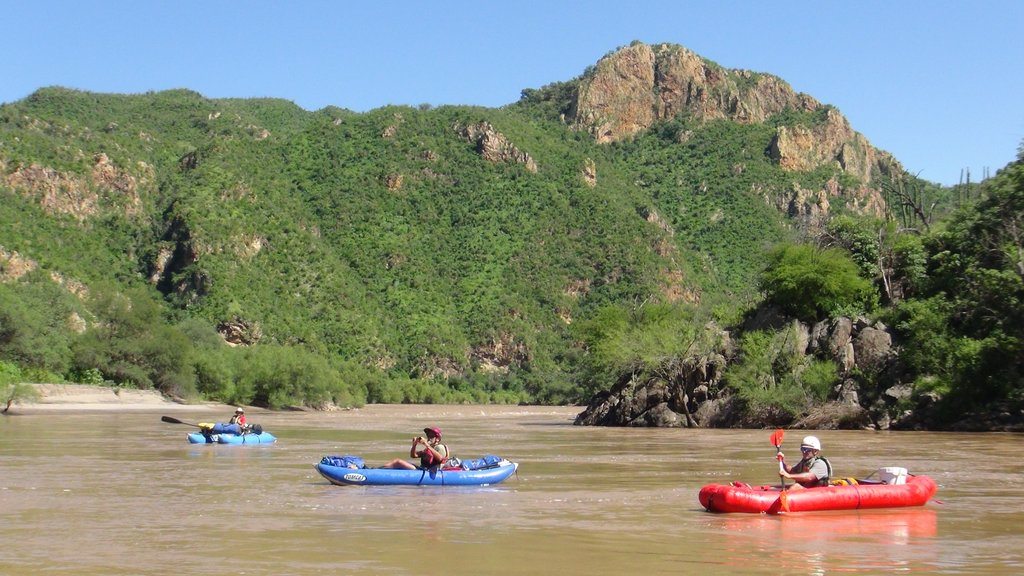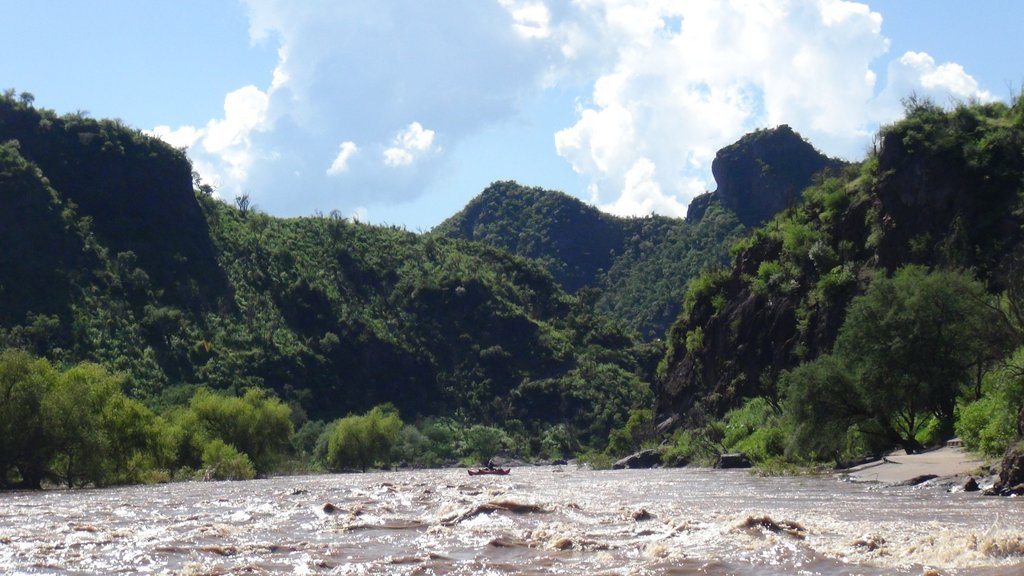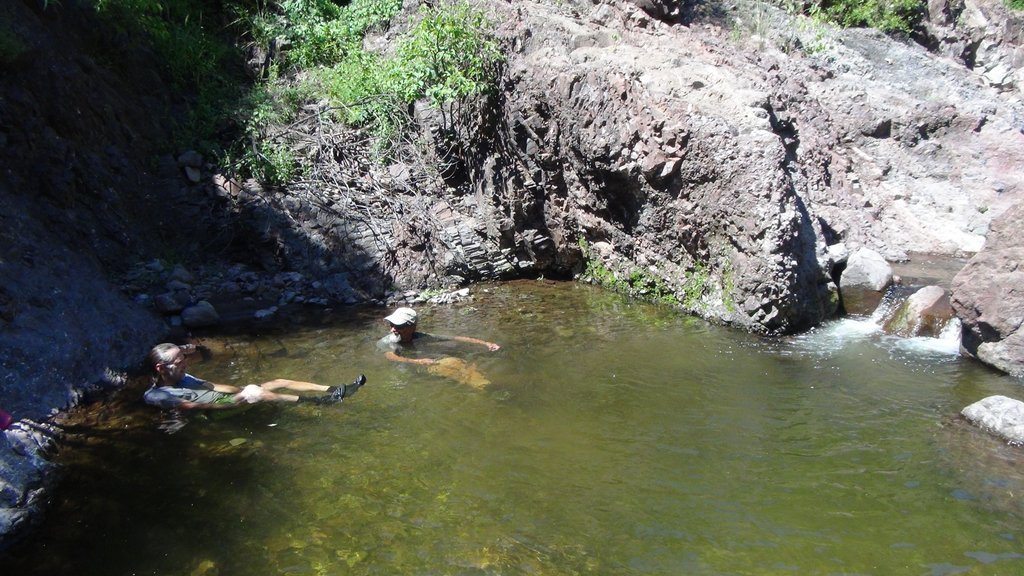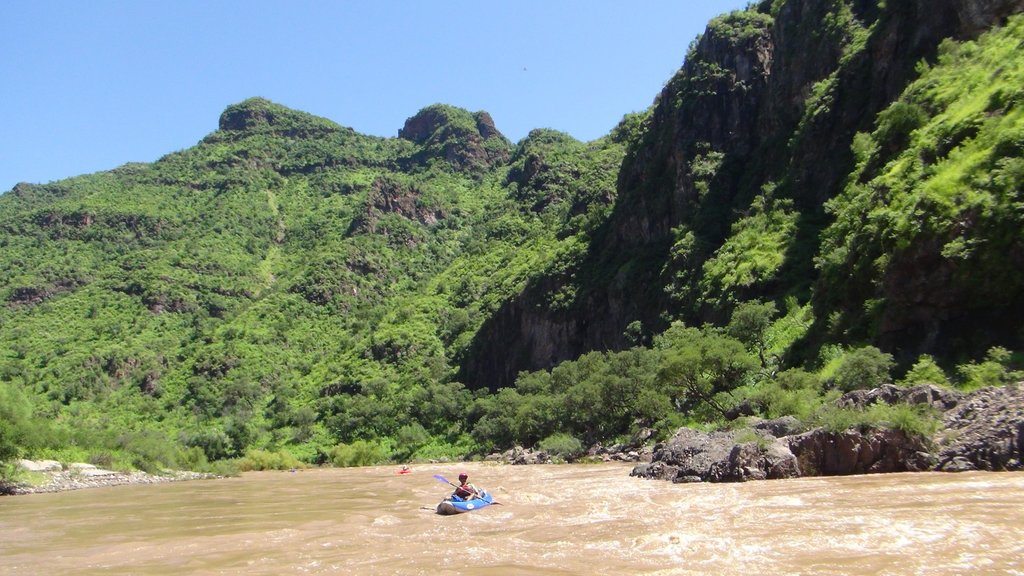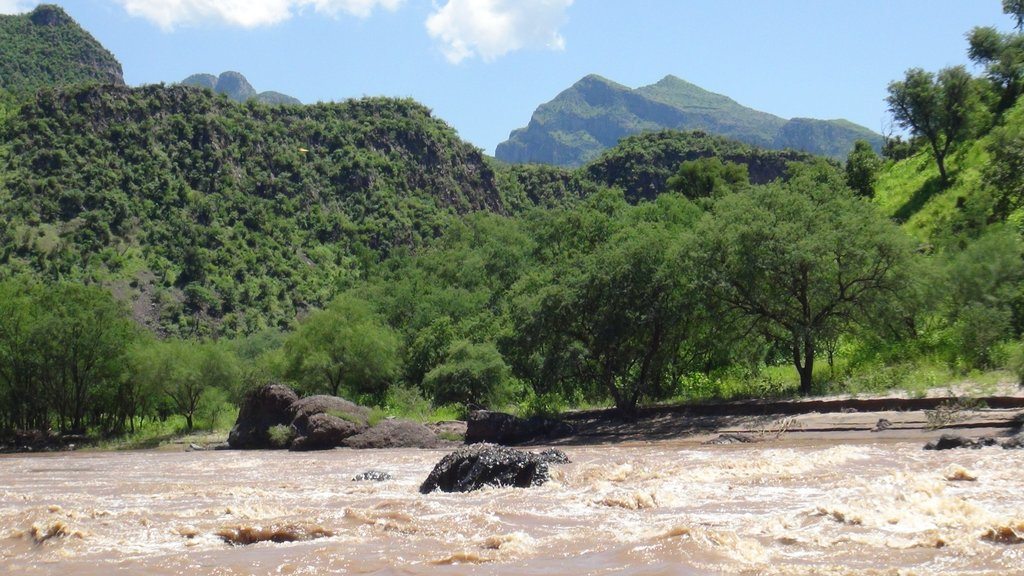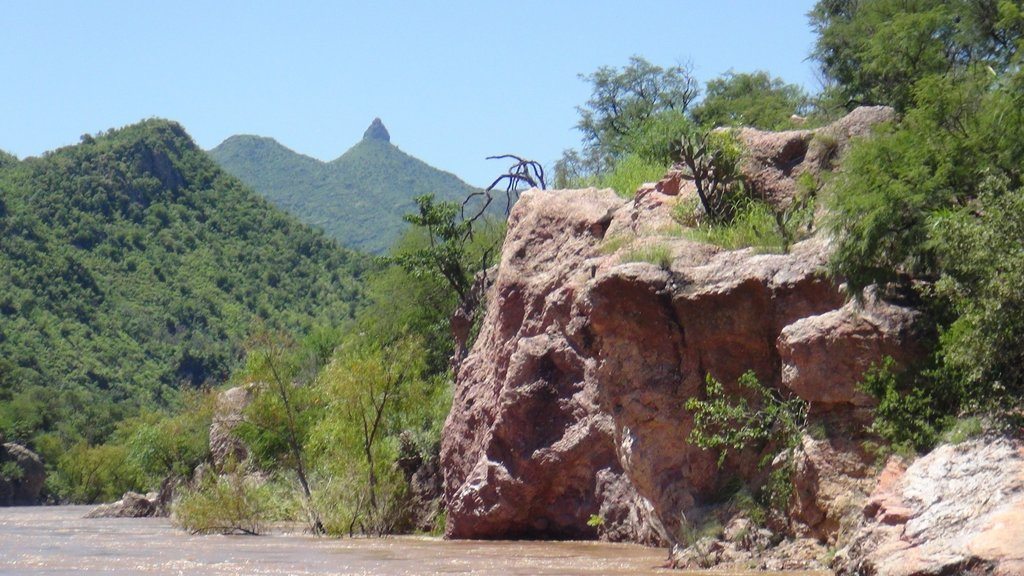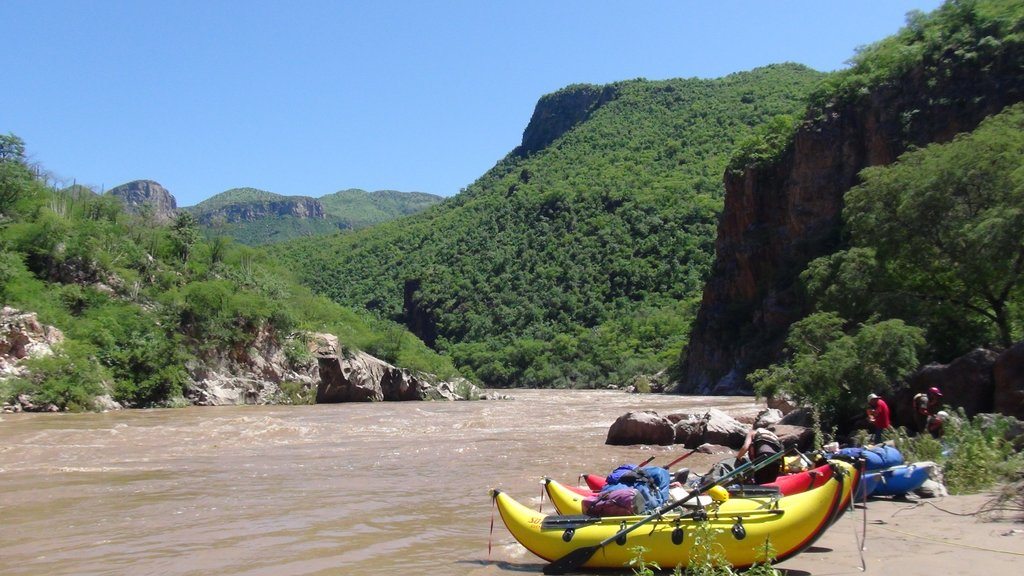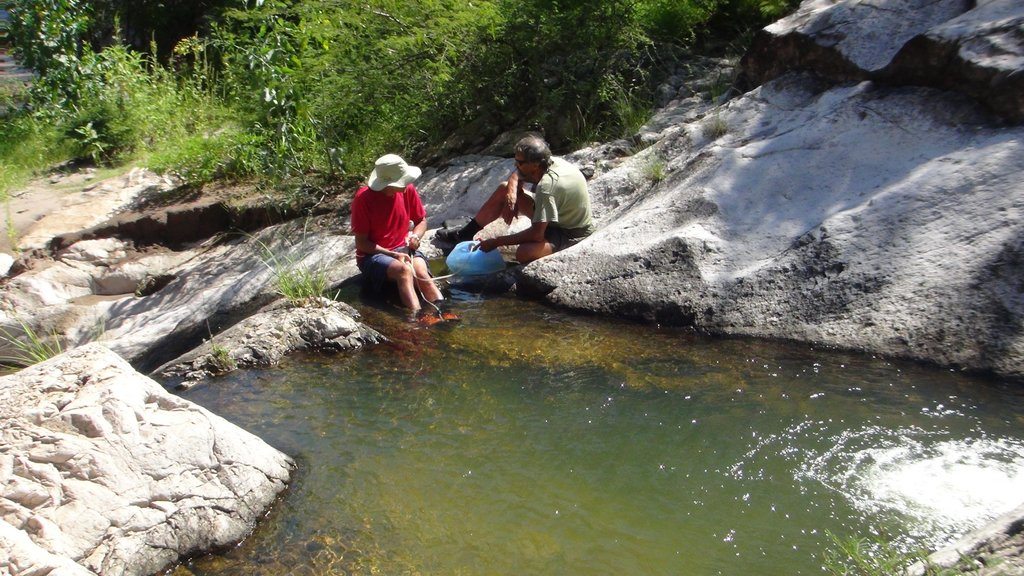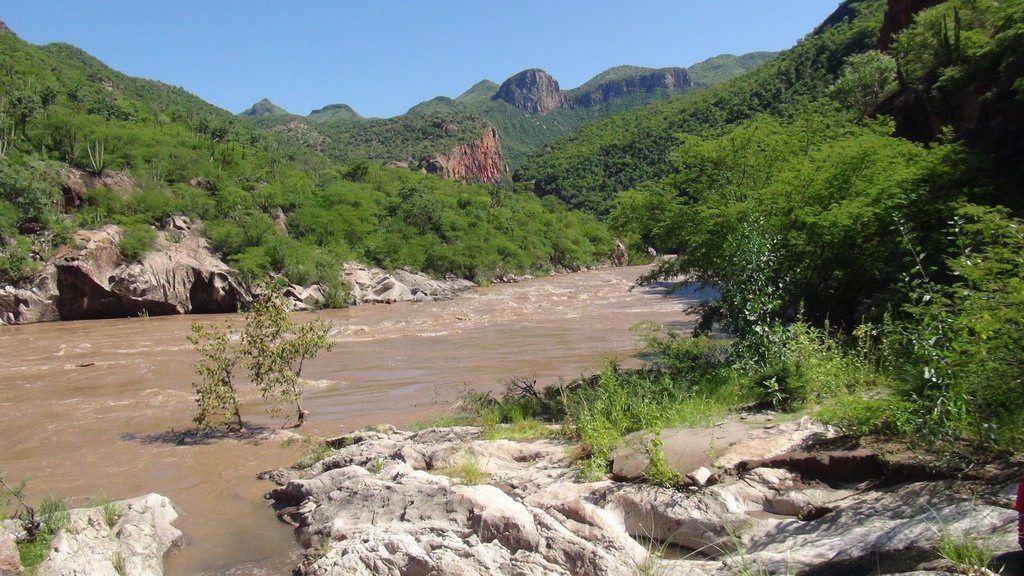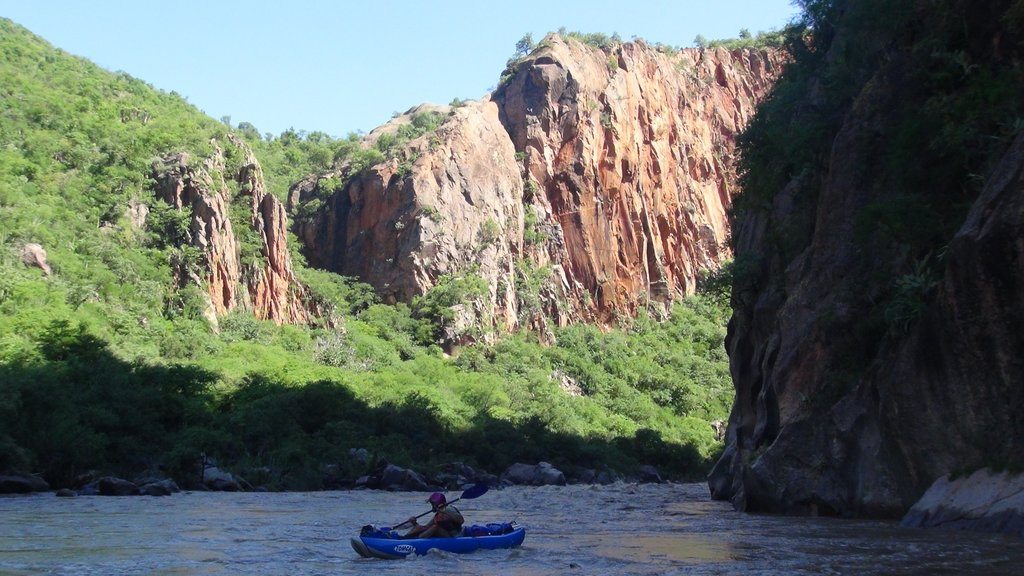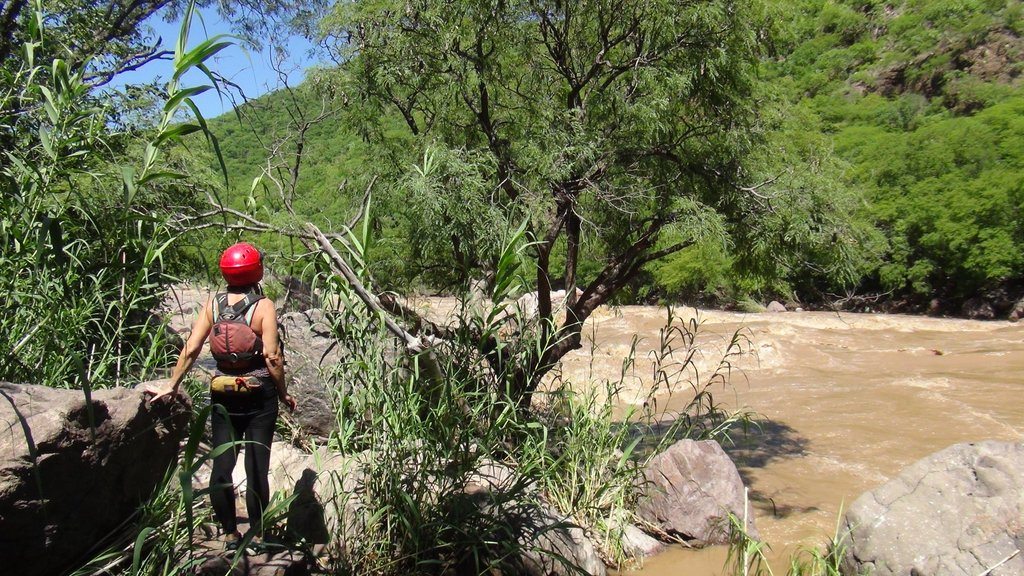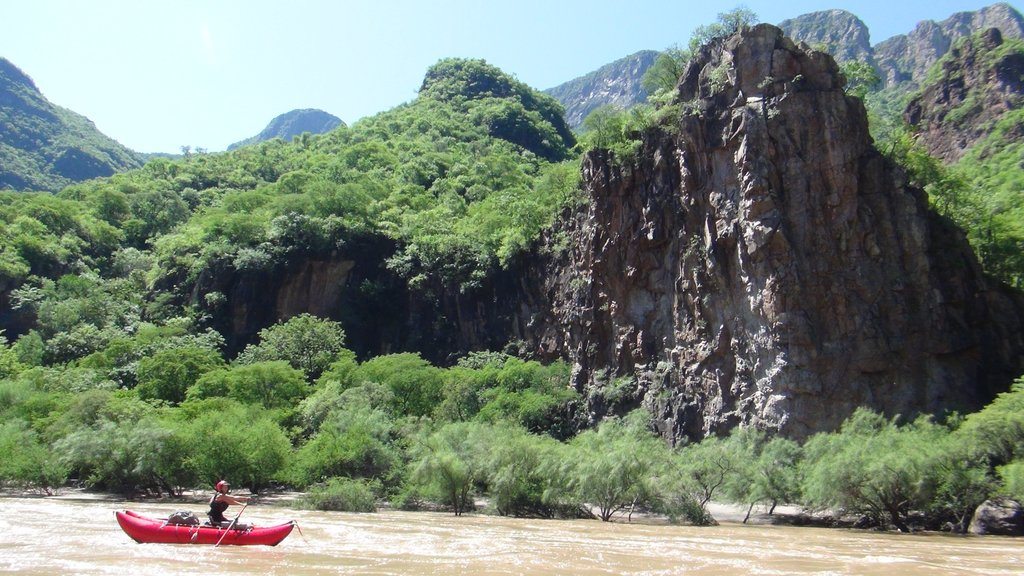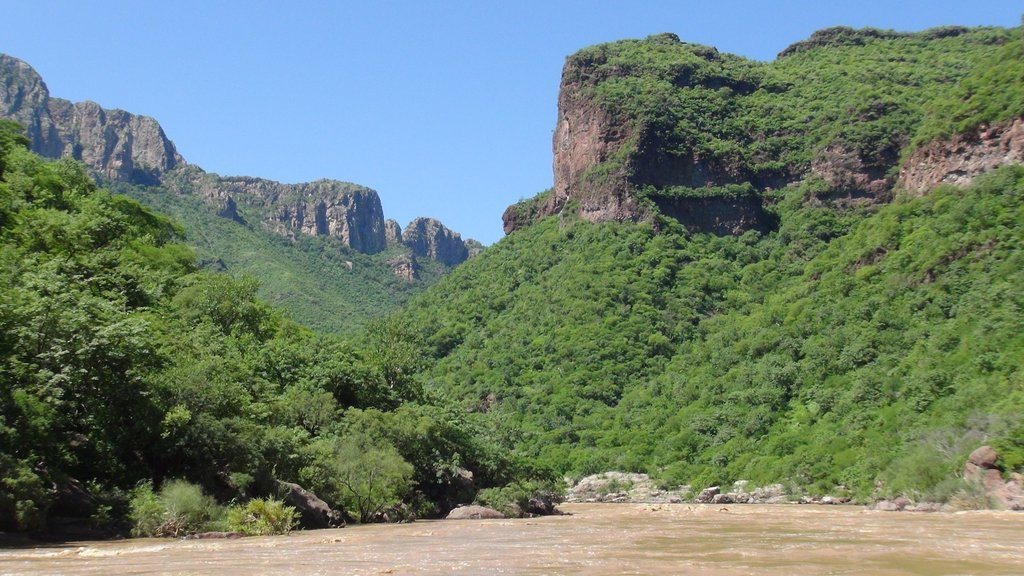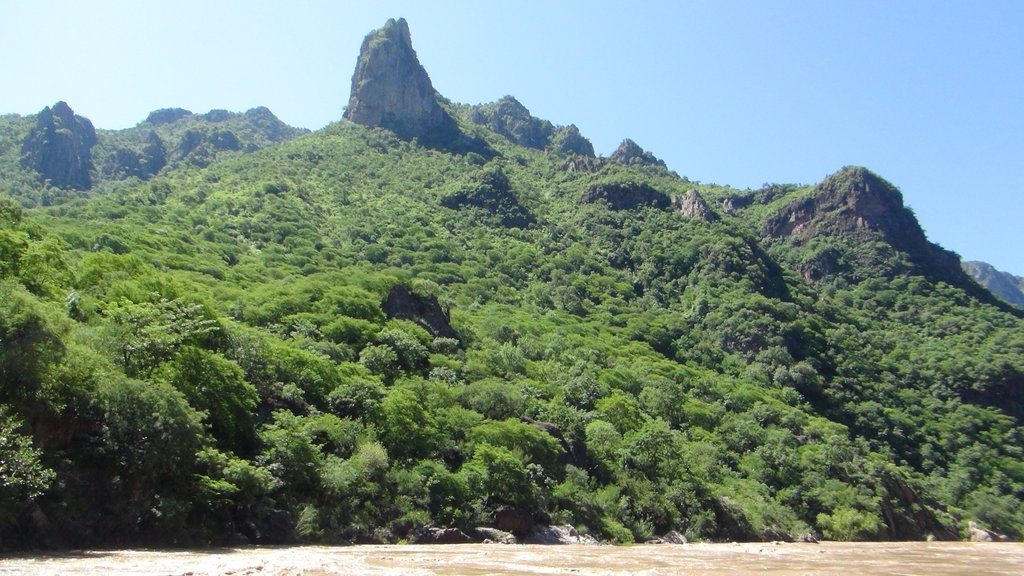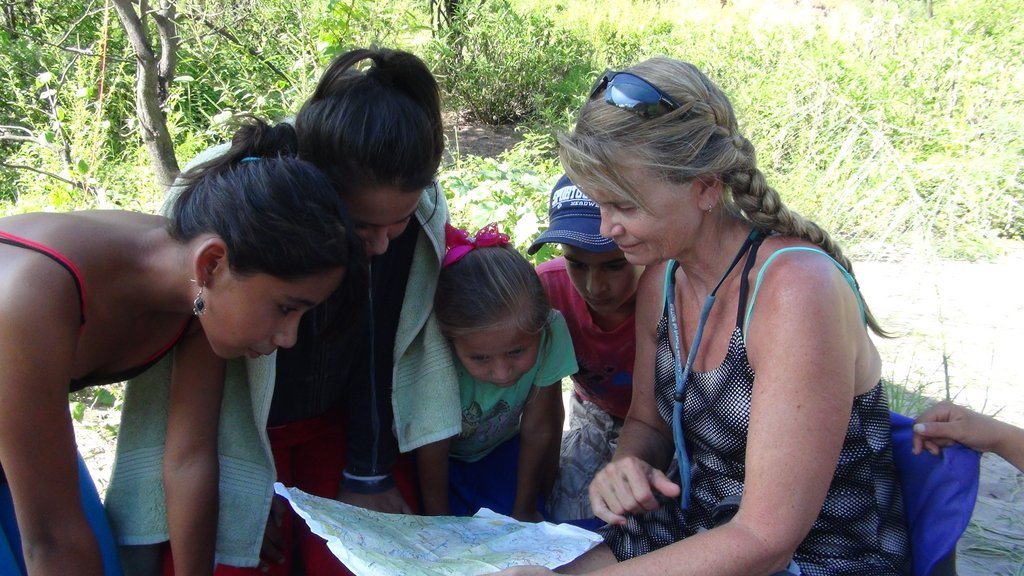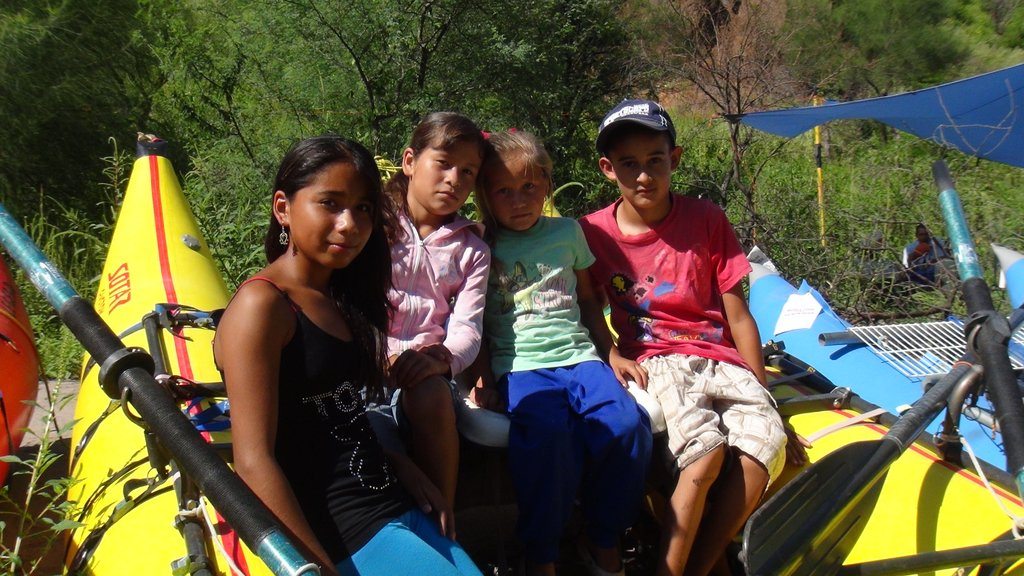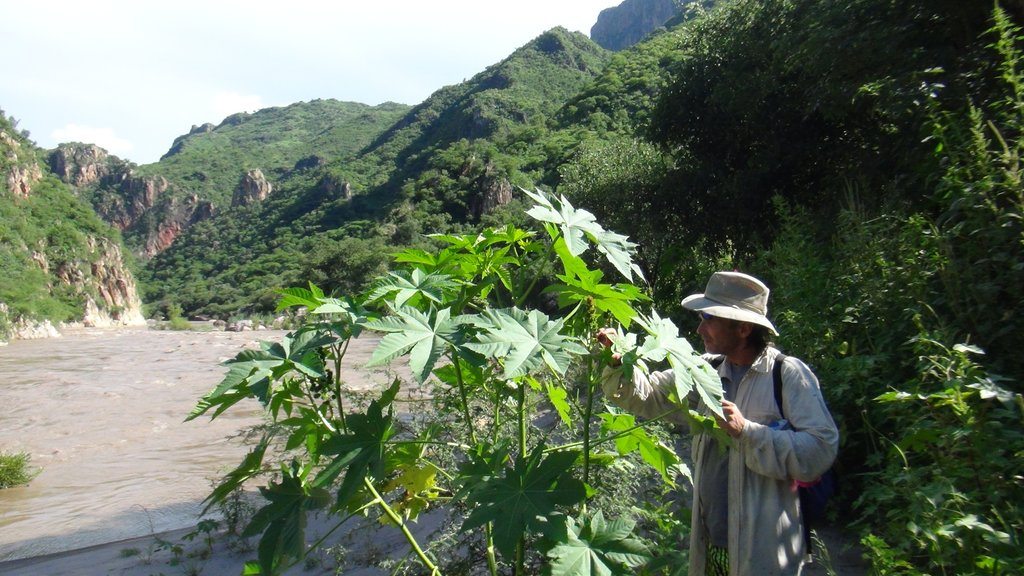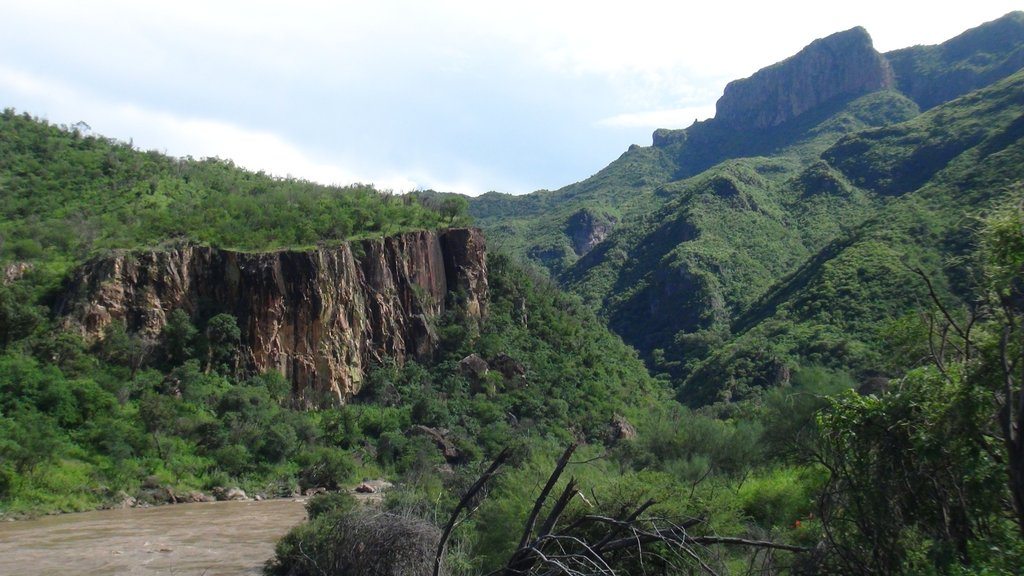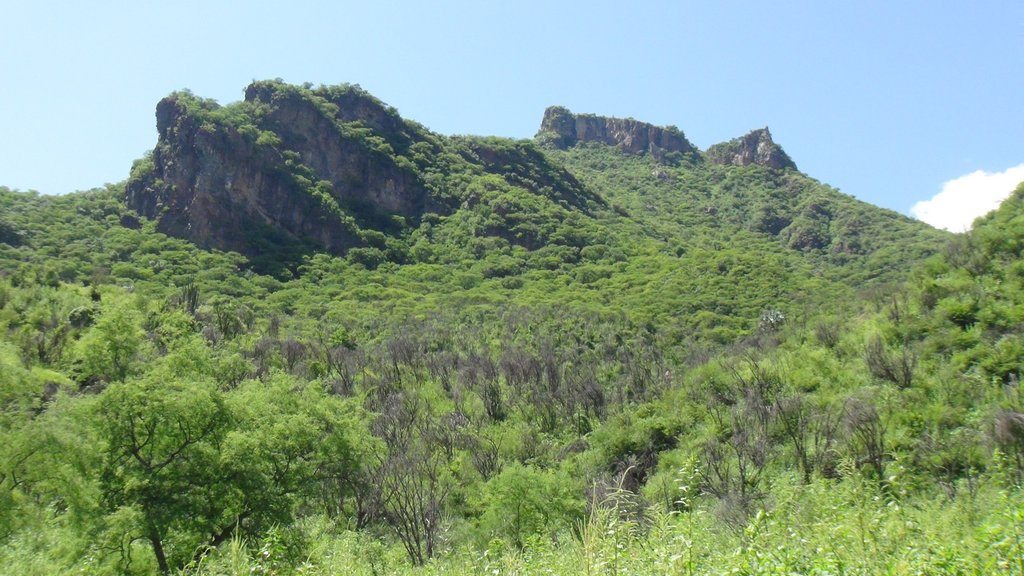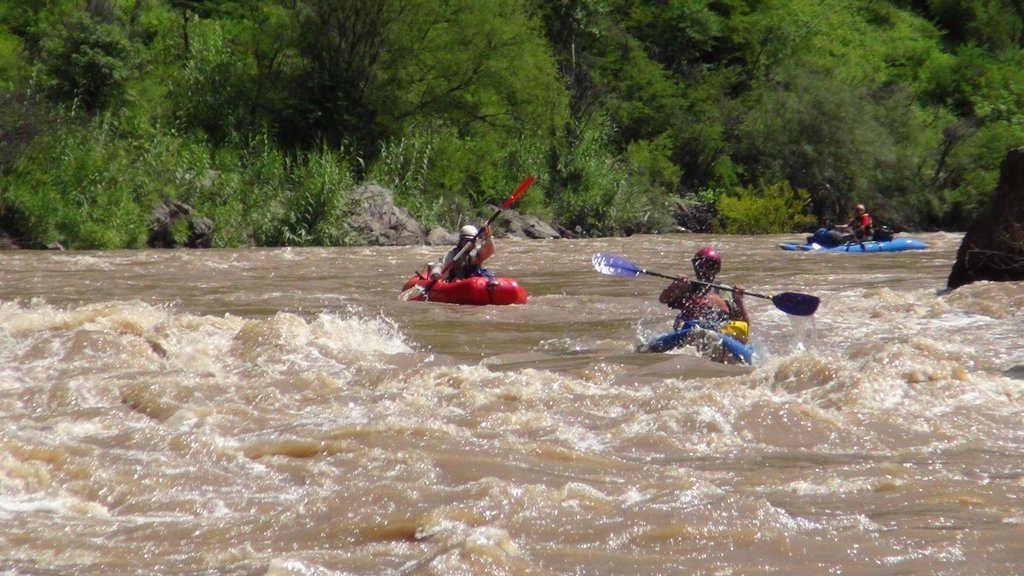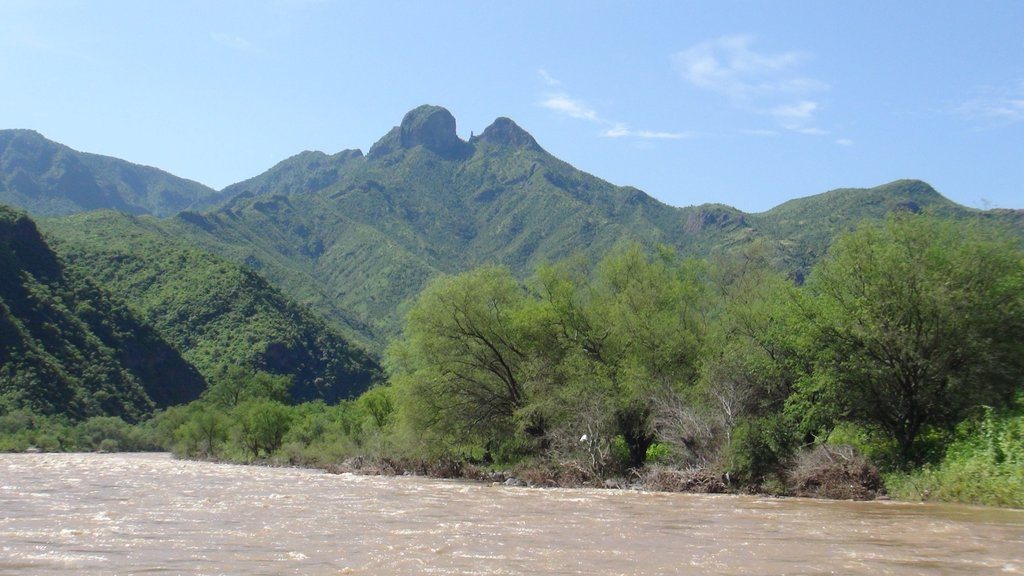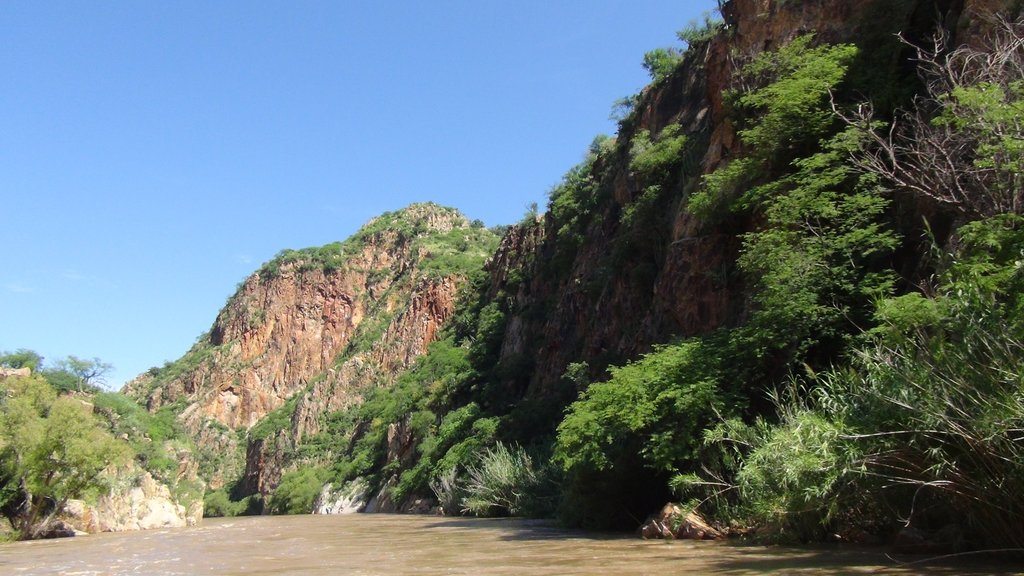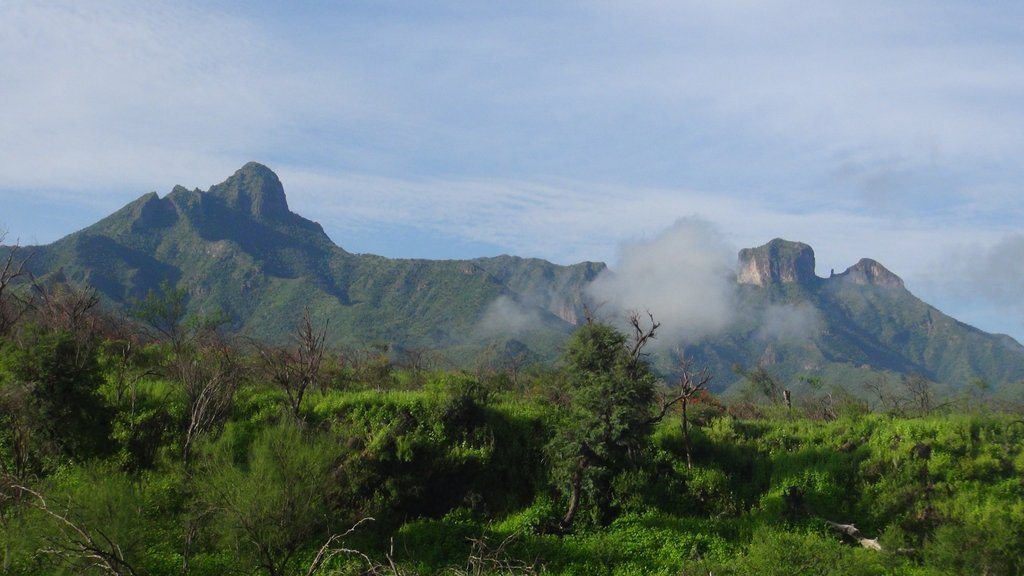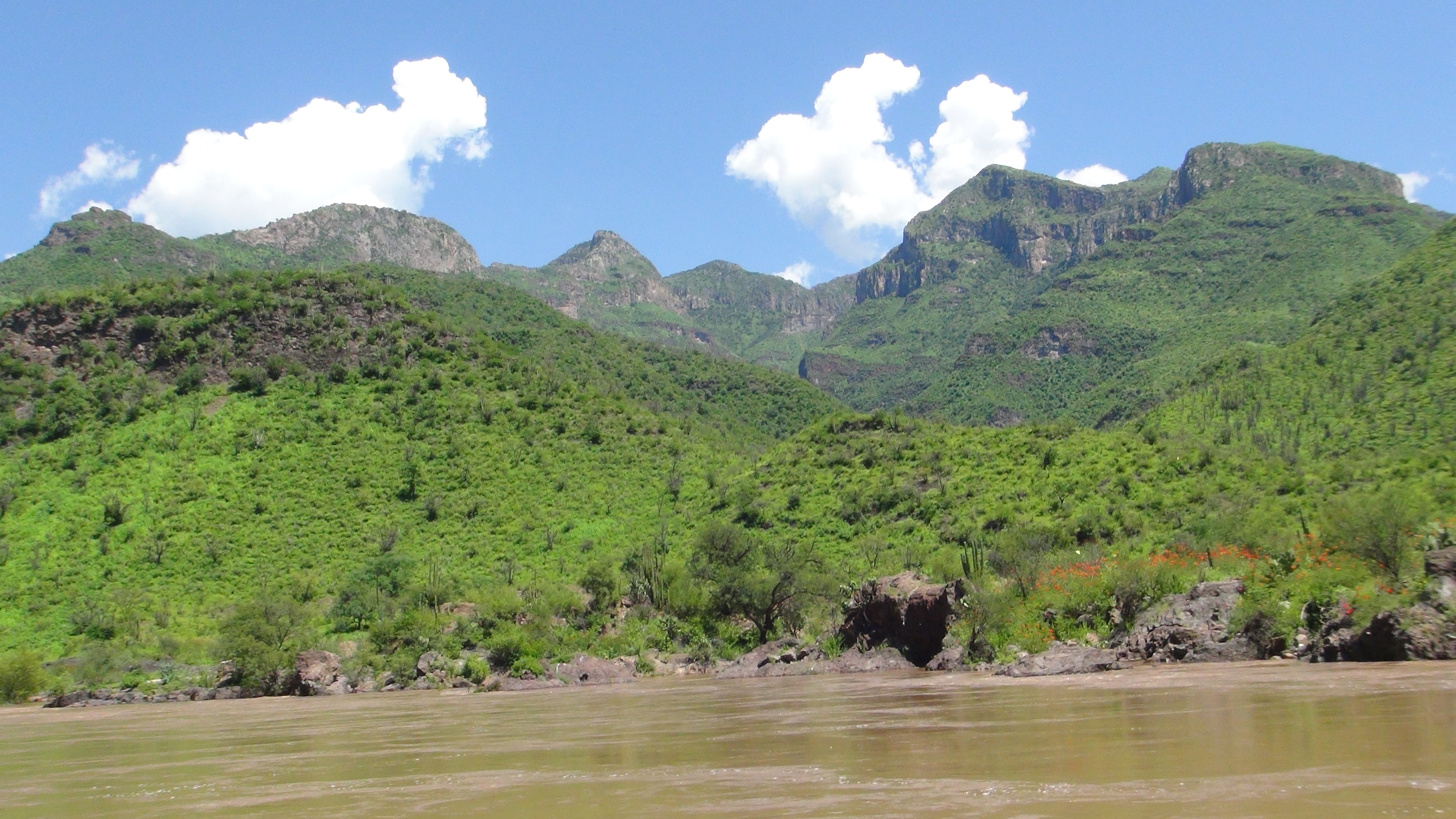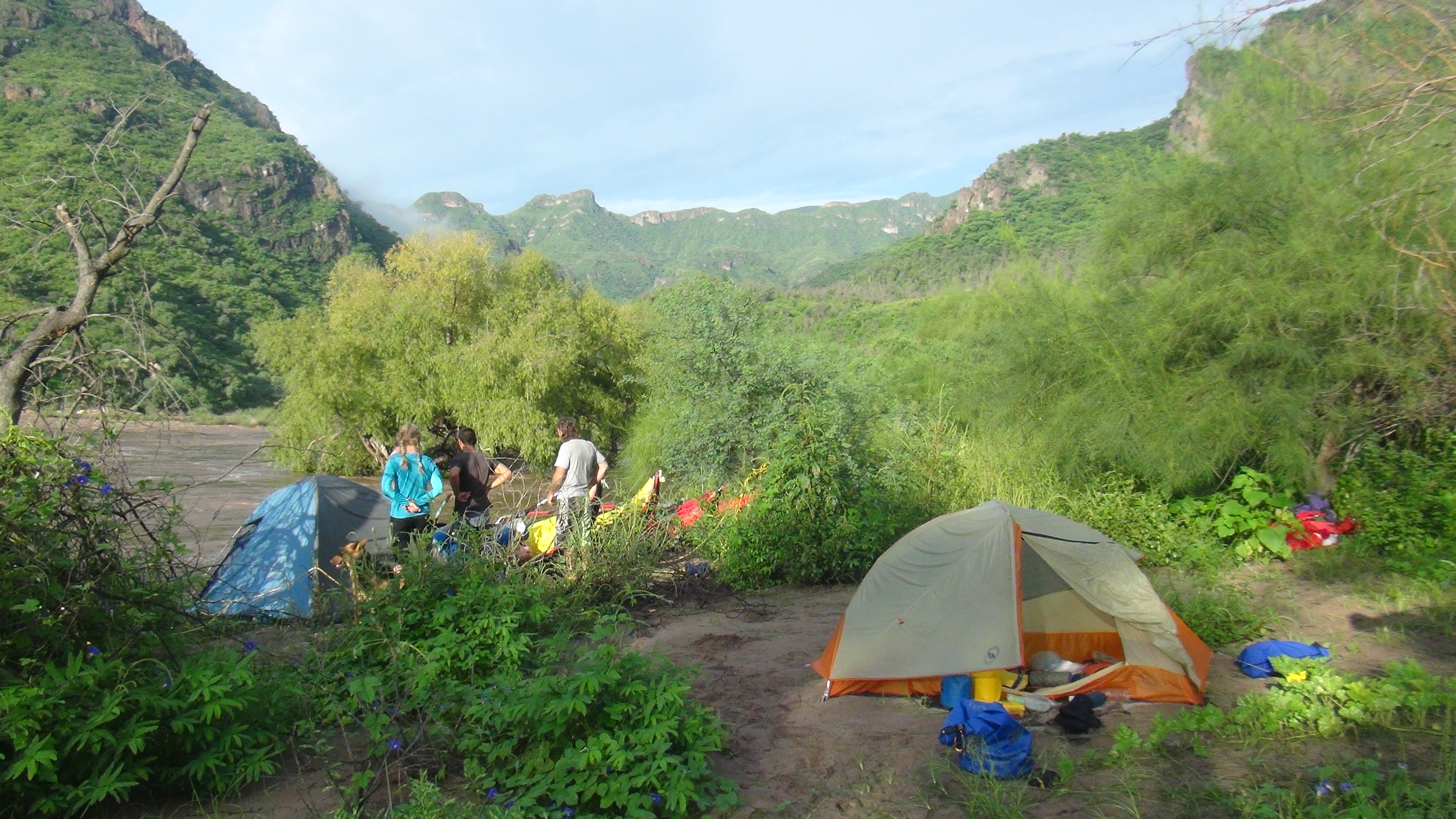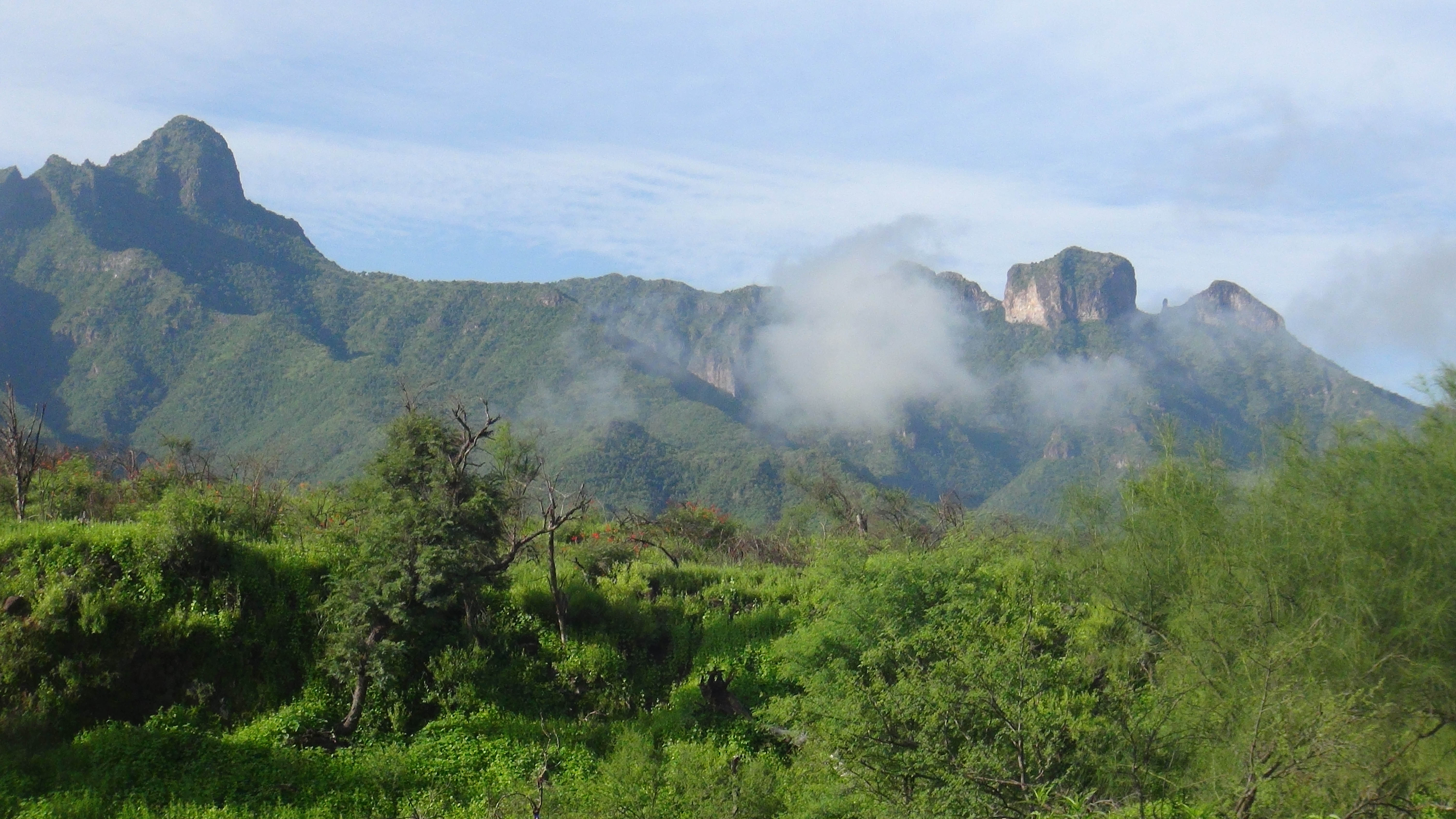Having done both tributaries of the Rio Aros, the Rio Mulatos (2010 and 2011) and the Verde/Upper Sirupa (2013), we were keen to complete the “trilogy” and run the remaining headwater stream, the Rio Tutuaca. In 2013, we had scouted access to the Rio Tutuaca and the area around Rancho El Nogal, just north of the town of Yepachi. This area is extremely beautiful and the river below El Nogal looked promising. The beta from our friend Rocky was that the section above El Nogal was prone to low water and very difficult for a raft, with some Class V water and some spots likely to be narrower than our catarafts. Below El Nogal was another difficult section with at least one more constriction before the next access point, the bridge below Mina Dolores. Below the Mina, there should be mostly Class II and III water through a breathtakingly scenic canyon to the confluence with the Rio Sirupa (forming the Rio Aros). Once on the Aros, there should be a section with up to Class IV water before reaching the confluence with the Mulatos where we would again be on familiar ground.
Our reconnaissance in 2013 convinced us that we just had to do the Rio Tutuaca and upper Aros! It certainly seemed possible to access the river below Mina Dolores as that is an active and busy mine. The road looked good and we were told it was a 4 hour drive in to the mine (about 100 km). Poring over the topographic maps and looking at images on Google Earth, the rapids of the Tutuaca and upper Aros certainly looked runnable in our catarafts. We started making plans to return in 2014, hopefully with other adventurous people that weren’t scared of going into Mexico.
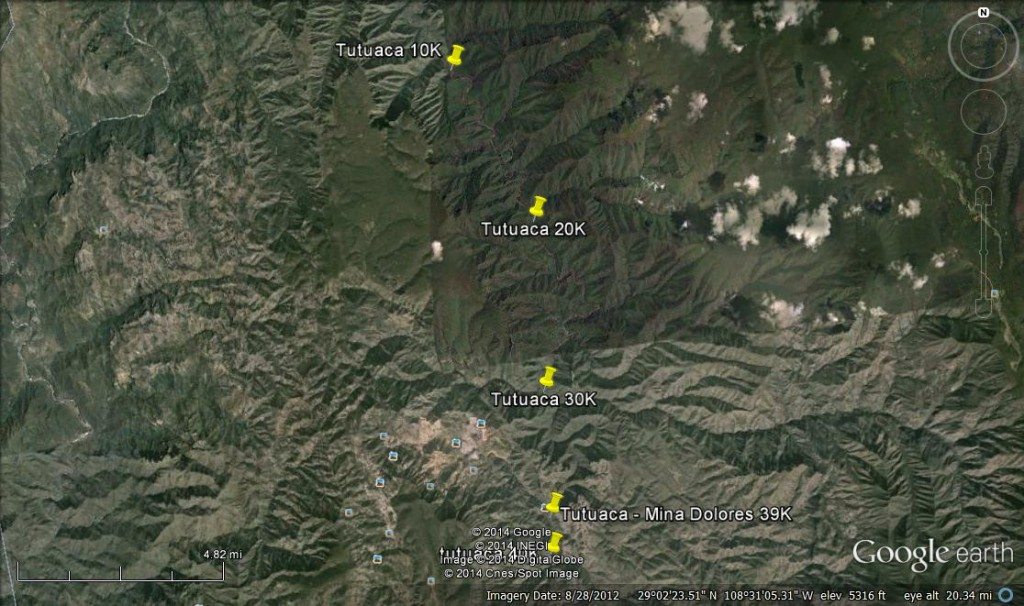
Putting the word out, we encountered the usual skepticism about boating in Mexico. You can boat in Mexico? In August? Is it safe? All reasonable questions and the answer to each being a resounding YES! One by one, people would express a little interest and then drop out. Oh well, Lacey and I were convinced that even if everyone dropped out, we were going to do it ourselves. We eventually got together a group of 5 people including Lacey (the No Coolers Lady) and I. The rest of the group consisted of Mike Huckaby, Steve Susswein, and John Maier.
Mike is co-owner of Copper Canyon Trails, an outfit in Tucson that offers hiking trips into the Copper Canyon region, and an avid explorer of the desert canyons of Sonora and Chihuahua. Mike had very little experience in an inflatable kayak and was renting my Sotar ATV kayak for the trip. What he lacked in boating experience, he more than made up for with knowledge of the area, contacts, and his language skills. Steve is a fellow boater from Salt Lake that we had met on the MF Salmon a couple years ago. For this trip, Steve had brought along his small cataraft with a rowing frame. John is a “retired” builder/handyman from Benson, AZ who boats many of the desert rivers in his inflatable kayak and is a friend and hiking companion of Mike.
Our little group met in Douglas, AZ the morning of August 20 and headed south. First stop, the border, where as usual, it was an easy thing to get our tourist visas and temporary vehicle import permits. The harder part was finding the supermarket and stocking up on the remaining food for the trip. Loading up on beans, tortillas, and other essential foodstuffs, we headed down the road to Sahuaripa, a 5-hour drive. From the bridge over the Rio Yaqui outside of Sahuaripa, we could see that the water was up, a good sign as long as it didn’t get too high! These rivers have a tendency to rise and fall an amazing amount very quickly. Such is the way of things during the monsoon season. We stayed the night at Hotel Casa Grande and met Mike’s friend Diego (a local dentist) who had arranged for our shuttle driver (Manuel). We also met with Manuel and explained that he would need to ride with us to the put-in (in Chihuahua State) and likely wouldn’t be back for about two days. We would cover his meals, lodging, and fuel for Steve’s van, as well as pay for his time driving. Everything was looking good! We loaded up Steve’s van in the morning, piled everyone in, and set off for Yepachi. Even with Manuel’s shortcut, it takes at least 5 hours.
 We got to Yepachi late in the day; too late to drive in to the put-in, so we looked up our “friend” Lucy who runs a hotel/restaurant in town. She was a bit more lucid this trip than last time, but did warn us about the dangers we would be facing – lions with long claws, a snake with red eyes! Yikes! Since her place was full of family we had to stay elsewhere and found some clean rooms at Hotel Del Mina right next to the road to the mine/put-in. A quick breakfast and lots of coffee and we’re on our way to the put-in. This is a beautiful drive through the mountains and even with the recent rains, the road was in great shape (as expected). It took about 5 hours to get to the bridge with a short stop to purchase some diesel (out of a barrel) so that Manuel would have enough fuel to get back to Yepachi. The mine itself is extensive and ugly, but the final descent to the river gave us a glimpse of the beauty to come.
We got to Yepachi late in the day; too late to drive in to the put-in, so we looked up our “friend” Lucy who runs a hotel/restaurant in town. She was a bit more lucid this trip than last time, but did warn us about the dangers we would be facing – lions with long claws, a snake with red eyes! Yikes! Since her place was full of family we had to stay elsewhere and found some clean rooms at Hotel Del Mina right next to the road to the mine/put-in. A quick breakfast and lots of coffee and we’re on our way to the put-in. This is a beautiful drive through the mountains and even with the recent rains, the road was in great shape (as expected). It took about 5 hours to get to the bridge with a short stop to purchase some diesel (out of a barrel) so that Manuel would have enough fuel to get back to Yepachi. The mine itself is extensive and ugly, but the final descent to the river gave us a glimpse of the beauty to come.
The put-in had great access to the river just above the bridge. With the high water, there were no eddies at the put-in so it was run and gun into the boulder maze below the bridge. The maze was really only Class II, but if you ended up in the wrong spot, it could have been deadly – a sieve that went underneath a boulder. Everyone made it fine, but I think Mike would have liked a bit more time to warm up and get used to the kayak.
The first few kilometers down to our camp were through an area called the “Walls of the Giants” and it was absolutely beautiful. The sheer fluted walls of the Tutuaca rose straight up several hundred feet. With the high water, the water was way up the tree trunks. We would have to look carefully for a place to camp. The vegetation was a vibrant green as the plants were responding to the plentiful rain. The river was, of course, a rich brown color.
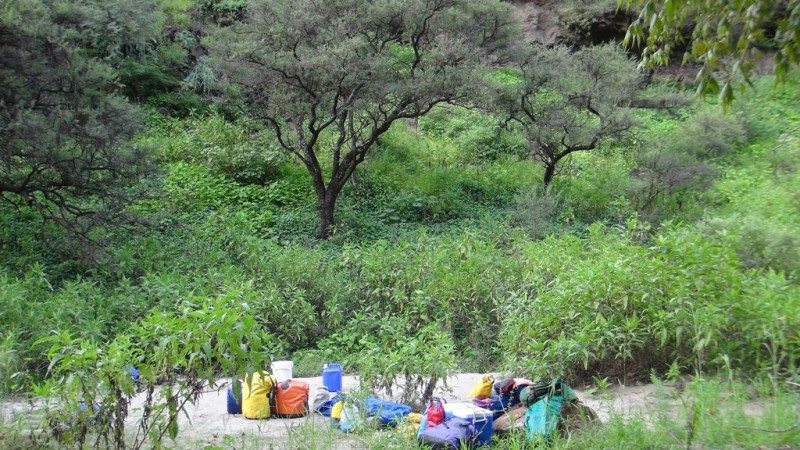
First Camp on the Rio Tutuaca
We did find a camp a few kilometers down on a low bench, not ideal, but very pretty with a nice waterfall across from us. The next day brought mostly Class II water and more pretty scenery, although we did leave the “giants” section. Quite a few cows were seen, especially later in the day before camp. The next day there were several Class II-III rapids in succession, leading to what we thought would be the hardest rapid on the Tutuaca (it was). A class IV-ish rapid I dubbed “S-turn.” The right channel was a difficult S-turn with a final drop off of a rock promontory into a sizeable hole. With the high water, an island formed leaving a sneak route on the left. Everyone ran left through the shallows and a final rocky chute. Class II water down continued to the confluence with the Sirupa.
The Sirupa was flowing strong, we now had about 5 times the flow and it was rising! We were a bit apprehensive for Mike and John in the IKs, so we made an early camp just downstream to wait and see what the water would do. It turned out to be a nice camp, we could hike, and John even saw a Gila monster on his hike. This area is very pretty too, but inhabited. Logs and debris were evident in the churning river, but by morning the water was down a bit, so we pushed on.
Most of the un-named Class III’s we were expecting were washed out to Class II wave trains. Just past the village of El Refugio, the river splits into multiple channels that rejoin and lead into a substantial hole with the high water. I motioned everyone over to the right to avoid it. Mike and John had to paddle hard, but made it to the eddy on the right. The water is BIG and powerful, probably flowing around 15,000 cfs.
Below El Refugio is more Class III water. I pull over below one and watch in horror as Mike paddles furiously to avoid a mid-stream rock – and doesn’t – wrapping the IK securely on the upstream side. Luckily he is OK and scrambles onto the rock. He attempts to pull the loaded IK off the rock, but the current is just too strong. I manage to row out and get into the eddy behind the rock and begin working with him to unwrap the boat. Pulling on one end in the current with my cat doesn’t seem to do it, so I scramble onto the rock with him and get a strap around a tube on one end of the boat. Working together we are able to lift with enough force to peel the IK off the rock where it swings into the eddy below (still strapped to my cat) and rights itself. I row us both over to shore towing the IK to assess the damage. Gone is one drybag of canned goods and the spare paddle (Lacey’s). We are glad to have Mike and the boat back in one piece. When we stop for lunch and scout “Slapper” the water starts rising, so we camp there and watch as Slapper goes from Class III to almost nothing as the water rises about 3 feet. We decide to be cautious about continuing as the hardest rapids in the Aros are yet to come. We camp there and go for a hike to scout what is below and find fresh water.
There is a great clear stream entering about a 15-minute hike downstream where we swim and filter our drinking water (not necessarily in that order!). We see that for at least a couple of kilometers downstream there are no major rapids, but the river does re-enter a narrower canyon area beyond where we stop hiking. We return to camp to find the curious locals from El Refugio and the surrounding ranchos have been stopping in. The water continues to rise and comes within 6 inches of our tents overnight.
Locals continue to stream in over the next day while we wait for the water to go down. Mostly they are just curious and want to take pictures of themselves (cell phones) sitting on the boats in paddling gear. They can share with other villagers or hike up the hill a bit to find cell service and post on Facebook. Isn’t technology grand! We learn that another loco gringo comes in October (maybe April?) and runs the Aros in his IK (to Natora?) and then hikes back to get his truck left at El Cable upstream of the confluence on the Sirupa.
The next day, we decide to push on in spite of the high water. Mike and John are feeling good about moving on and we’ll stop and scout anything that looks questionable. Vaqueros I has some big waves but is still Class III as expected. Vaqueros II is washed out. Aros Fury is less furious than expected, although it has some big waves that can be avoided on the right. Aros Fun is a fun Class III with big waves. We stop above Olas Grandes I as it looks a bit serious and we can’t see the bottom of the rapid from up above. It turns out to be a Class IV-ish rapid with more serious consequences. There is another huge wrap rock at the top and several holes in the center channel, some of them very nasty. We see that there is a route on the far left that avoids most of the gnar, but it has some weird currents and you could get pushed back out to the center above a nasty keeper hole. We decide to portage the IKs and run the cats down the left. It takes about an hour, but everyone gets through safely. Olas Grandes II is much easier, a big-water Class III where both John and Mike hit the biggest waves and go flying through (upright, yeah!) but Steve gets knocked off his seat and swims briefly with the boat. Camp is below in a beautiful setting with awesome views of some cliffs.
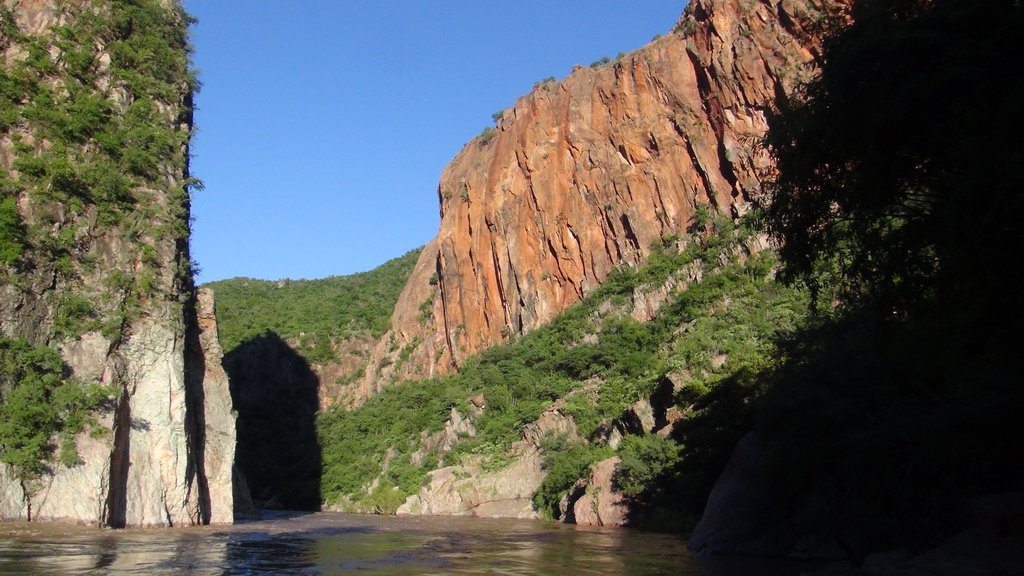
We find another great watering hole downstream where we can filter water and cool off in the pools. Such a beautiful stretch of the river. The rapids are mostly big-water Class II’s with some large hydraulic features to avoid. Mike doesn’t avoid them all and takes a couple of swims, but emerges no worse for wear. We pass the mouth of the Rio Mulatos and it has much less water. It does look like an adequate amount to run the Mulatos though. With the high water, it is more difficult to find good camps on the Aros. The next day we stop in Natora to hopefully call our shuttle driver to say we will be a couple of days later than anticipated. It turns out to be relatively easy to call, get some lukewarm beer, and pick up a few provisions for the rest of the trip. We meet Ezequel who happens to be in Natora to pick up another boater. It turns out our friends Rocky and Boris are taking a group down the Mulatos at the same time. They will catch up with us downstream and we all take out together a few days later.
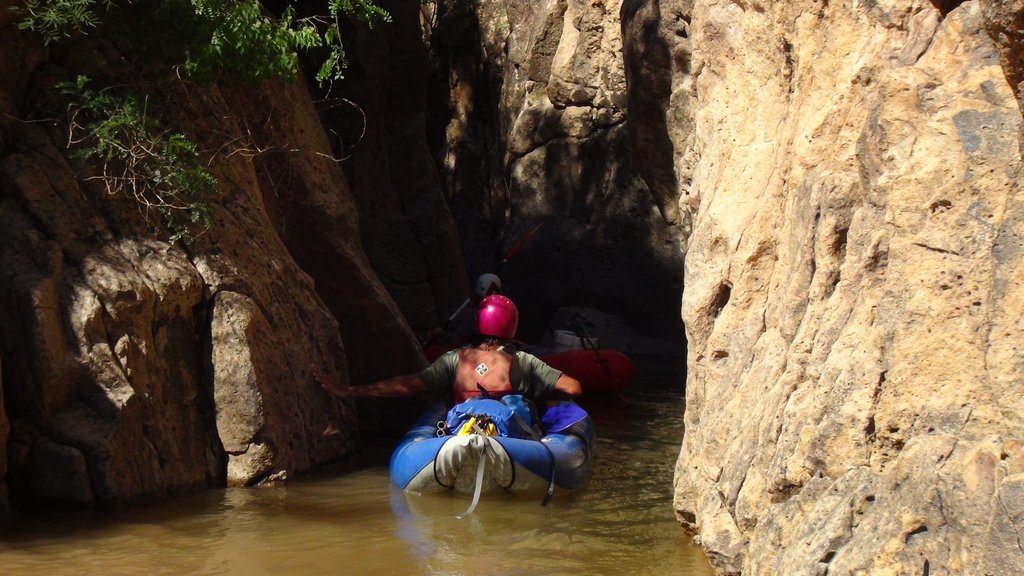 The lower Aros/Yaqui is much as it has been the last few times we have boated down here, beautiful and non-threatening. Mostly Class II-III on the Aros and maybe Class II on the Yaqui. Flows are initially higher than we have seen before, but recede quickly to more normal flows. Arroyo El Aliso is flooded enough that the IKs and Steve’s small cat can paddle their way up the slot. Very cool! Lone Palm Gorge is still a beautiful section too. We camp for the first time right above Roca Roja on a great multi-tiered sandbar. Everyone does fine going through the rapid in the morning. We stop at the cave and some inquisitive coatis come to visit. The other group catches up with us here, but misses the coatis. The flow at Paso de Nacori is around 200 cms (7,000 cfs) but was closer to 550 cms (19,000 cfs) just a few days earlier while we were on the upper Aros. No wonder it seemed big! The rest of the Aros/Yaqui is pretty uneventful although John did take a brief dip at Morita. Just cooling off I guess. It is a long, hot row out to Rancho El Rio where Rocky’s shuttle drivers are waiting. Jose (the owner) is also there as usual. We hitch a ride into town with them and return with our vehicles to load up gear before heading into Sahuaripa for the night. All in all, a great trip. Next year we will explore more of the lower Sirupa and/or upper Tutuaca! Join us if you can.
The lower Aros/Yaqui is much as it has been the last few times we have boated down here, beautiful and non-threatening. Mostly Class II-III on the Aros and maybe Class II on the Yaqui. Flows are initially higher than we have seen before, but recede quickly to more normal flows. Arroyo El Aliso is flooded enough that the IKs and Steve’s small cat can paddle their way up the slot. Very cool! Lone Palm Gorge is still a beautiful section too. We camp for the first time right above Roca Roja on a great multi-tiered sandbar. Everyone does fine going through the rapid in the morning. We stop at the cave and some inquisitive coatis come to visit. The other group catches up with us here, but misses the coatis. The flow at Paso de Nacori is around 200 cms (7,000 cfs) but was closer to 550 cms (19,000 cfs) just a few days earlier while we were on the upper Aros. No wonder it seemed big! The rest of the Aros/Yaqui is pretty uneventful although John did take a brief dip at Morita. Just cooling off I guess. It is a long, hot row out to Rancho El Rio where Rocky’s shuttle drivers are waiting. Jose (the owner) is also there as usual. We hitch a ride into town with them and return with our vehicles to load up gear before heading into Sahuaripa for the night. All in all, a great trip. Next year we will explore more of the lower Sirupa and/or upper Tutuaca! Join us if you can.
This is not our first journey down the rivers of northern Mexico. We love the rivers of the Rio Yaqui basin and have now done the Rio Mulatos twice, the lower Aros/Yaqui four times, and the lower Tutuaca/upper Aros once (this trip). Check out our other trip reports!

